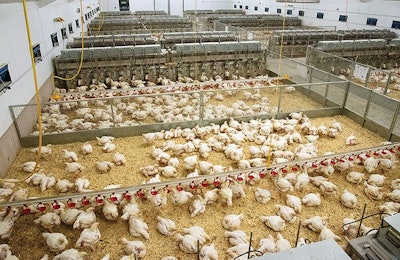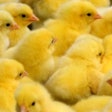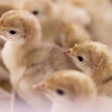
The world is changing and the poultry industry, along with the rest of agriculture, is facing the steep challenge of feeding more people using less resources. Meanwhile, consumer preferences are changing in the developed world pressuring the industry to produce animals with high welfare using minimal medication.
Primary breeders, who supply the birds grown by integrators around the world, shoulder much responsibility in solving these problems. Magnus Swalander, director of research and development at Aviagen Limited in the United Kingdom, explained how breeders are putting greater emphasis on developing a more sustainable animal in response to these challenges.
“Modern broiler breeding involves true balanced selection, with more than a third of all selection pressure focused directly on health and welfare related characteristics: from gut health to livability and leg strength,” Swalander said as part of his remarks at the Boehringer Ingelheim GmbH's Poultry Innovation Days, an event that took place in March 2018 in Prague, Czech Republic. “Feed efficiency, with its importance for environmental and economic sustainability, remains one of the most important traits, however, selection for growth rate is much lower than what may have been applied 20 years ago."

Magnus Swalander, Aviagen | Photo by Benjamín Ruiz
Swalander said responsible, sustainable breeding is about minimizing inputs, like feed, water, litter material and antibiotics, and maximizing meat output but also achieving the highest possible health and welfare outcomes. Primary breeders are at the top of the supply chain, and they are charged with making all the genetic selection and therefore genetic progress.
“Our prospective approach is to keep this improvement in a balanced fashion for both broiler and breeder characteristics, with continued focus on selecting the most healthy, high welfare, efficient and environmentally sustainable chicken,” Swalander said.
Changes in broiler breeding
Swalander said breeding techniques and priorities have changed dramatically in the recent past. In the 1960s, increased growth was the main priority for breeders. Today, growth is a small part of selection, sharing value with a range of other efficiency, health and welfare traits such as gut health, skeletal development, meat yield and quality as well as new traits like water utilization efficiency.
Breeders must also deal with traits that carry differing degrees of heritability. Swalander said it’s relatively easy to select for body weight.
“It gets complicated when you start adding in different characteristics that you select for at the same time, which have a lot lower degree of heritability, such as fertility, hatchability or livability,” he said.
To select for these traits, and balance all of the demands, breeders must record more data and use better technology. Swalander said Aviagen considers about forty different types of characteristics in total.
Improving meat production
In genetic improvement programs, meat production developed greatly. Through computational tomography, breeders combine the evaluation of the musculature development for each bird and register the information in processing plants in order to select for body composition and quality.
This equipment is the same as what’s used in hospitals: a CT, or computerized tomography, scanner. Passing a bird through the scanner takes 20 to 25 seconds. About 700 birds can be scanned each day. With this equipment, breeders can view each tissue separately and focus on registering traits associated with health and productivity. For example, breeders can better understand the bone health of an animal through measurements of tibial dyschondroplasia (TD) as well as through other aspects of meat quality.
Meat quality
In terms of meat quality, two different areas are evaluated. The first is muscle quality, the physical qualities of the breast muscle and the elimination of every type of defect. Breast meat problems like deep pectoral myopathy (DPM), which are uncommon today, are something that’s been included as a selection tool in the breeding programs of the past. More recently, this examination has included the evaluation of woody breast syndrome. Benefits of this selection are starting to appear in the field now.
The second area is eating quality. Typically, this assessment was performed with tasting panels. However, these panels depended upon tastes which differ from region to region around the world. Now, selection focuses on the chemical composition of the meat, along with the tenderness and texture which can be measured objectively using near-infrared (NIR) spectroscopy

The quality of the muscle tissue and the elimination of breast meat defects are a priority for the industry. | Associação Brasileira de Proteína Animal
Robustness and gut health
Evaluating foot pad defects and conducting gait scoring analysis are key aspects to examine intestinal health and robustness, in addition to using X-ray technology to identify the incidences of TD in the birds. Each bird that presents signs of this defect are rejected for any breeding.
Because of this, the incidence of TD has fallen to about 4 percent in 2019 from about 25 percent in 1993, and it continues to fall. At the same time, body weight increased by between 1 and 1.5 percent every year of the same period.
In terms of intestinal health, breeders select for the footpad health, water consumption and multi-environmental tolerance. Footpad scoring is centered on the quality of the skin. In order to select a bird with better intestinal health, breeders utilize methods like multi-environmental tolerance directed at the immune system and the individual water intake.
The real world
Parent stock needs to be located in installations with very strict biosecurity, but at the same time, the breeders must select birds which would be more robust and function well in real world environments.
It’s imperative to select birds when they can express their maximum genetic potential in growth, heart and lung function. Therefore, breeders locate brothers and sisters of the same pedigree in a production system on a completely separate farm that is not biosecure, with built up litter and high levels of bacterial and viral load, among other real-world factors. In these conditions, breeders try to identify a good muscle tone, color and intestinal villosity.
Birds are also selected for increased immunocompetence. Instead of selecting against specific disease on their own, breeders take a wider and holistic approach. This gives the birds greater robustness and an immune system that can resist different health challenges and function in a range of production environments around the world.
Slower-growing breeds
Swalander said breeding changes made today will take between four and five years before they manifest further down the supply chain, so breeders must consider that timeline. Right now, there are more types of birds than there likely have been in the past 20 years. The markets are more diversified and there’s an increase in demand for slower-growing and colored breeds.
With conventional chicken breeds, breeders look for a growth rate of a bit more than 60 grams per day. For other breeds, either white or colored, they look for about 50 grams per day. For organic and other non-conventional birds, associated with higher feed needs and lower breast yields, the rate can be as low as 35 grams per day.
From an environmental point of view, the best thing to select for is feed conversion and growth rates, which are the biggest drivers of carbon dioxide emissions. After this, come factors like yield, livability and egg production.
Is there a limit in feed conversion?
Feed conversion is critical for economic and sustainability reasons. To evaluate it through feed consumption, breeders use a transponder-based system. Each bird in a pen wears a transponder. When they approach a feeder, the device registers the exact number of grams of feed consumed during each feeding session.
Chickens will never be like fish, with a 1:1 feed conversion ratio (FCR), but there are some individual birds who have achieved close to a 1.2 FCR. This means there is sufficient opportunity for further improvement.
Swalander said if feed conversion is improved by 0.025 points per year, globally, that is equivalent to 2.38 million tons of feed – or 340,000 hectares of land – potentially saved annually. The industry could potentially produce more chicken with the same amount of feed in order to feed the growing world population.
Consumers focused on meat quality, production practices
Consumers want antibiotic-free chicken, ethical animal welfare and safe handling practices as well as birds that are free of defects, such as woody breast, said Dale Woerner, Texas Tech University, at the 2019 International Production & Processing Expo.
Read more:
Changing nature of global meat production comes under focus, www.wattagnet.com/articles/35790


















